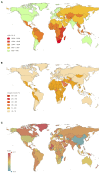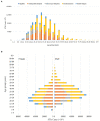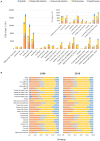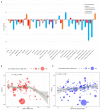Incidence Trends of Five Common Sexually Transmitted Infections Excluding HIV From 1990 to 2019 at the Global, Regional, and National Levels: Results From the Global Burden of Disease Study 2019
- PMID: 35308518
- PMCID: PMC8924524
- DOI: 10.3389/fmed.2022.851635
Incidence Trends of Five Common Sexually Transmitted Infections Excluding HIV From 1990 to 2019 at the Global, Regional, and National Levels: Results From the Global Burden of Disease Study 2019
Abstract
Objective: Sexually transmitted infections (STIs) are common worldwide and pose a challenge to public health. We conducted this study to assess the annual incidence of five common STIs, including syphilis, chlamydia, gonorrhea, trichomoniasis, and genital herpes at the global, regional, and national levels.
Materials and methods: We obtained detailed data on STIs excluding HIV from 1990 to 2019 from the Global Burden of Disease (GBD) 2019 database. Estimated annual percentage change (EAPC) was calculated to quantify trends in age-standardized incidence rates (ASR) of STIs, stratified by gender, sociodemographic index (SDI) region, and pathogenic microorganism.
Results: Globally, incident cases of STIs increased by 58.15% from 486.77 million in 1990 to 769.85 million in 2019, but the annual change in ASR was only -0.04% (95% CI -0.09 to 0.01) per year. EAPC was 0.16 (0.06 to 0.26) for syphilis, 0.09 (0.05 to 0.13) for genital herpes, 0.06 (0.03 to 0.09) for trichomoniasis, -0.21 (-0.36 to -0.06) for chlamydia, and -0.14 (-0.19 to -0.08) for gonorrhea. High SDI regions reported significant increases in ASR of syphilis and chlamydia.
Conclusions: The burden of disease from STIs remains large, though control of STIs has contributed to the decreasing incidence in most regions, especially in the low-SDI regions. Globally, over the past 20 years, the ASR has remained stable for trichomoniasis and genital herpes decreased for chlamydia and gonorrhea, and increased for syphilis.
Keywords: STIs; chlamydia; genital herpes; global burden; gonorrhea; syphilis; trichomoniasis.
Copyright © 2022 Fu, Sun, Han, Wang, Xiao, Zhou, Gao, Fitzpatrick, Yuan, Li, Zhan, Lu, Luo, Duan, Hong, Fairley, Zhang, Zhao and Zou.
Conflict of interest statement
The authors declare that the research was conducted in the absence of any commercial or financial relationships that could be construed as a potential conflict of interest.
Figures





Similar articles
-
Increasing incidence rates of sexually transmitted infections from 2010 to 2019: an analysis of temporal trends by geographical regions and age groups from the 2019 Global Burden of Disease Study.BMC Infect Dis. 2022 Jun 26;22(1):574. doi: 10.1186/s12879-022-07544-7. BMC Infect Dis. 2022. PMID: 35754034 Free PMC article.
-
Global, regional, and national burden of HIV and other sexually transmitted infections in older adults aged 60-89 years from 1990 to 2019: results from the Global Burden of Disease Study 2019.Lancet Healthy Longev. 2024 Jan;5(1):e17-e30. doi: 10.1016/S2666-7568(23)00214-3. Lancet Healthy Longev. 2024. PMID: 38183996
-
Trends in the incidence of common sexually transmitted infections at the global, regional and national levels, 1990-2021: results of the Global Burden of Disease 2021 study.Trop Med Health. 2025 May 16;53(1):70. doi: 10.1186/s41182-025-00744-2. Trop Med Health. 2025. PMID: 40380279 Free PMC article.
-
Sexually Transmitted Infections: Impact and Cost-Effectiveness of Prevention.In: Holmes KK, Bertozzi S, Bloom BR, Jha P, editors. Major Infectious Diseases. 3rd edition. Washington (DC): The International Bank for Reconstruction and Development / The World Bank; 2017 Nov 3. Chapter 10. In: Holmes KK, Bertozzi S, Bloom BR, Jha P, editors. Major Infectious Diseases. 3rd edition. Washington (DC): The International Bank for Reconstruction and Development / The World Bank; 2017 Nov 3. Chapter 10. PMID: 30212101 Free Books & Documents. Review.
-
Diagnosis and Treatment of Sexually Transmitted Infections: A Review.JAMA. 2022 Jan 11;327(2):161-172. doi: 10.1001/jama.2021.23487. JAMA. 2022. PMID: 35015033 Review.
Cited by
-
Epidemiology of gonorrhea in countries of the Middle East and North Africa: systematic review, meta analyses, and meta regressions.BMC Glob Public Health. 2024 Aug 19;2(1):56. doi: 10.1186/s44263-024-00088-9. BMC Glob Public Health. 2024. PMID: 39681952 Free PMC article.
-
Congenital Syphilis-An Illustrative Review.Children (Basel). 2023 Jul 29;10(8):1310. doi: 10.3390/children10081310. Children (Basel). 2023. PMID: 37628309 Free PMC article. Review.
-
High Prevalence of Asymptomatic STIs in MSM PWH in a Male HIV Clinic in Mexico City.J Int Assoc Provid AIDS Care. 2025 Jan-Dec;24:23259582251321039. doi: 10.1177/23259582251321039. J Int Assoc Provid AIDS Care. 2025. PMID: 39967244 Free PMC article.
-
Acquired syphilis in older people in Brazil from 2010-2020.PLoS One. 2024 Sep 6;19(9):e0296481. doi: 10.1371/journal.pone.0296481. eCollection 2024. PLoS One. 2024. PMID: 39240879 Free PMC article.
-
Independent clinic-based evaluation of dual POCTs for screening for HIV and syphilis in men who have sex with men in Italy, Malta, Peru, and the United Kingdom.BMC Infect Dis. 2024 Feb 29;24(Suppl 1):192. doi: 10.1186/s12879-024-09019-3. BMC Infect Dis. 2024. PMID: 38418941 Free PMC article.
References
-
- GBD 2015 Disease and Injury Incidence and Prevalence Collaborators . Global, regional, and national incidence, prevalence, and years lived with disability for 310 diseases and injuries, 1990-2015: a systematic analysis for the Global Burden of Disease Study 2015. Lancet. (2016) 388:1545–602. 10.1016/S0140-6736(16)31678-6 - DOI - PMC - PubMed
-
- World Health Organization . Sexually transmitted infections (STIs) Key facts. (2020). Available online at: http://www.who.int/mediacentre/factsheets/fs110/en/.
-
- Newman L, Rowley J, Vander Hoorn S, Wijesooriya NS, Unemo M, Low N, et al. . Global estimates of the prevalence and incidence of four curable sexually transmitted infections in 2012 based on systematic review and global reporting. PLoS One. (2015) 10:e0143304. 10.1371/journal.pone.0143304 - DOI - PMC - PubMed
Grants and funding
LinkOut - more resources
Full Text Sources
Miscellaneous

